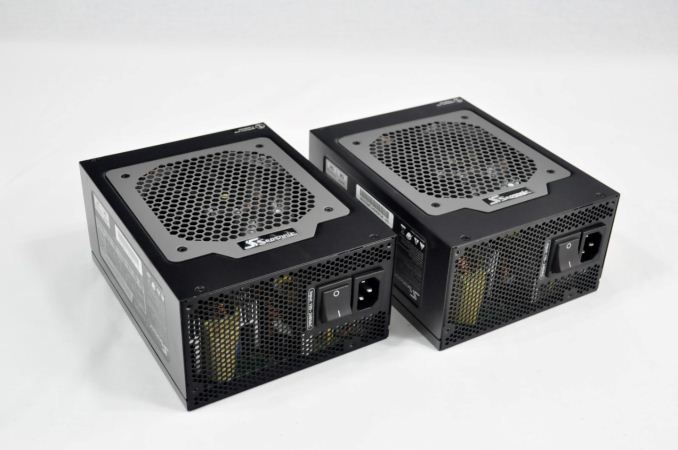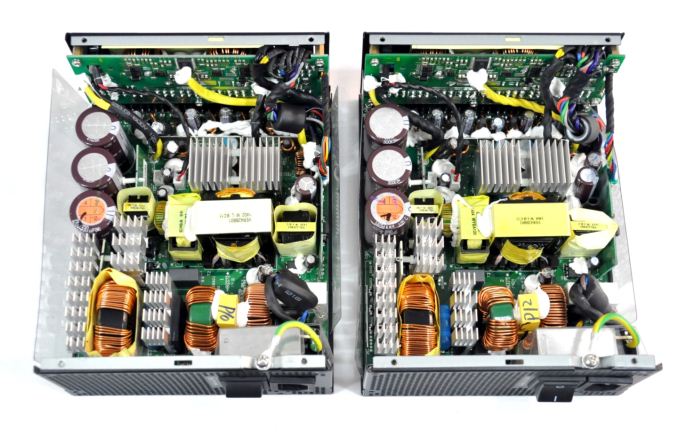Seasonic Platinum SS-1050XP3 & SS-1200XP3 Power Supply Review
by E. Fylladitakis on September 3, 2014 6:00 PM EST- Posted in
- Cases/Cooling/PSUs
- Seasonic
- 1200W
- 80Plus Platinum
- 1050W
Conclusion
Seasonic is one of the oldest PSU manufacturers and they are a very experienced company. There is no randomness about the products they design; each and every one of them serves an exact and specific purpose. This is also true for their two latest additions to the Platinum series that we have tested here today. With the power requirements of typical computers in constant decline, it is known that such powerful units have a very limited target audience.
Both of the units that we tested here today share the same external and internal design, with the only difference being the ratings of some components. Externally, the understated appearance and fully modular design will be appreciated by users. The design of the sides is a little tricky, as whether the user will be seeing a sticker with electrical specifications or decorative engravings depends on whether the PSU will be installed with the fan facing downwards or upwards.
Internally, we found an advanced full-bridge topology platform, components of the highest quality and an immaculate soldering job. The assembly job confounded us somewhat, as it is rather messy and we were surprised to see such a thing in a Seasonic product, but it should not really affect the performance or reliability of the PSUs. Besides, Seasonic covers these units with a seven year warranty, removing any concerns that we could express about the longevity of these units.
What both of the new Seasonic Platinum units really excel at is electrical performance. Both units displayed excellent energy conversion efficiency and outstanding power output quality, with the Platinum SS-1200XP3 slightly outpacing the Platinum SS-1050XP3. It appears that the more powerful components of the 1200W version give it a slight performance edge as well, despite the identical platform. They also maintain very low operating temperatures, even when heavily loaded and in adverse environments, yet at the expense of acoustic comfort. However, we do believe that very few users actually require their system to remain silent while it is heavily loaded.
The majority of the users that actually have to buy a >1kW PSU are either hardcore gamers or cryptocurrency miners. What hardcore gamers want is ample and clean power for their multi-GPU gaming system, ensuring its stability. Gamers also often seek good aesthetics, as their systems frequently include cases with windowed side panels. A gaming system requires very high power when loaded but just a small portion of it while performing simple everyday tasks. With the cooling profile that Seasonic's Platinum series has, the units will be quiet while the system is idling, discernable only when it is heavily loaded (i.e. while the gamer is actually gaming), and thus it is unlikely that any environmental noise will overcome the sound from the speakers or headphones.
Cryptocurrency miners on the other hand simply require highly efficient units that can sustain a continuous heavy load. Energy conversion efficiency is required for obvious reasons; when such a system is working 24/7, energy losses are important both financially and practically, as they cost the user money and heat up the unit, reducing its lifetime and performance. Seasonic's Platinum series units however have aggressive cooling profiles that will keep their operating temperature very low, even while the PSU is heavily loaded. Their efficiency at high loads is excellent as well, surpassing 92%. The seven year manufacturer warranty is the cherry on top for users that plan on running cryptocurrency mining rigs with these units, and likely the other components of the system will fail long before the PSU gives out. The high speed of the fan will definitely make these units loud under such conditions, but that is of little importance for cryptocurrency mining rigs.
The Seasonic Platinum SS-1050XP3 currently retails for $230 and the 1200W Platinum SS-1200XP3 can be purchased for just $20 more at the time of this review. Considering the small price difference and the slightly better performance, the 1200W version potentially offers a better value, though if the pricing gap widens, the 1050W version may become more appealing. As far as competition goes, Seasonic's new units are considerably cheaper than most of the competitive products. The Platinum SS-1200XP3 is $50 cheaper than Corsair's AXi series (e.g. $300 after rebate for the 1200W version), but it's simpler and without Corsair's Link interface. It's also cheaper than Cooler Master's V1200 Platinum ($300 as well, though it's only $252 on Amazon), with the only actual competition coming from the Leadex-based EVGA Supernova P2 1200W ($232 at the time of this review).
Ultimately, the number of use cases for 1kW and higher PSUs is rather limited. For cryptocurrency mining rigs, the good price and specific performance profile of the Seasonic Platinum units makes them an excellent choice. Of course, GPU mining has become generally unprofitable at this stage, so buying a new $200+ PSU could take the better part of a year to break even. Gamers on the other hand will have to consider other factors as they decide whether the Seasonic Platinum units can fully cover their needs or if they require the features and/or different performance profile of another model. Seasonic delivers high quality PSUs with their XP3 series, and does so at reasonable prices, so if you're in the market for such a power supply they're worth a look.












39 Comments
View All Comments
ijozic - Thursday, September 4, 2014 - link
It sounds like it would cost noticeably more for something most people PROBABLY won't really care about. And the market is already quite competitive..Samus - Thursday, September 4, 2014 - link
The only complicated factor is space inside the standard ATX housing, but considering there are 500-watt 80+ Gold SFX PSU's that are 1/3rd the size of ATX, making a 100-watt primary stage with a 1000-watt secondary stage shouldn't be impossible. The most expensive part would likely be the cap for the relay (1/4 farad) and obviously that cap is going to be pretty large, most electrolytic caps this size are around 5" long.I think the BOM would be ~$20, and engineering it in isn't rocket science. This could totally be done, and if I were paying $200+ for a PSU, I'd expect some level of engineering beyond a good bridge design and PFC.
jann5s - Thursday, September 4, 2014 - link
have a look at the pico-PSU, these go up to 160W and are approximately the size of the ATX-plug attached to the umbilical coard of your PSU, this will definately fit.DanNeely - Thursday, September 4, 2014 - link
With a picoPSU you need to look at not just the 12V to 3.3/5V (smaller models) or 19V to 12/5/3.3V circuitry on the ATX plug; but the size of the external power brick used to feed it. It's still probably feasible volumetrically, but isn't nearly as much of a gimmie as just looking at the size of the ATX plug module implies.DanNeely - Thursday, September 4, 2014 - link
... especially since this could potentially be done by beefing up the existing Vsb circuit instead of adding something entirely new. JonnyGuru's testing shows current Vsb implementations aren't particularly impressive at only around 80%; but depending on how much worse current models perform below 10% some gains might still be reasonable. With the Titanium spec mandating 90% efficiency at 10% load though I'm not sure it's really worth it. On the 300-700W units that are suitable for ~90% of enthusiast systems 10% of rated power is generally enough to cover idle loads as long as you don't do anything silly (eg running an IGP powered low power mITX board with an SLI capable PSU). OTOH idle loads are steadily improving with each new CPU/GPU generation and the 80+ group will need to extend the standard to be tougher somewhere for whatever comes after titanium.TelstarTOS - Thursday, September 4, 2014 - link
I totally agree. What's holding me to get a 1000W+ PSU is the efficiency at low loads. With CPUs getting more and more green, PSUs should do the same and not only when under full load (which is a countersense if you really think about it).DanNeely - Thursday, September 4, 2014 - link
More attention is being paid to lower end efficiency than in the past; and this PSU is a prime example. While it falls short of the (new) 90% efficient at 10% load requirement for 80+ titantium, it's ~89% efficiency is much better than any of the other PSUs reviewed earlier this year did; none of which did better than the low to mid 80's at that level.Phillip Wager - Monday, September 8, 2014 - link
i like the dual stage idea but i am assuming most consumers are not willing to pay more for additional cost/complexity because that small amount of power that you are wasting turns out to be a very small amount of money over the lifetime of the system. I am somewhat suprised with your test results with your system because my computer has nearly identical specs and i have a 600 watt power supply and i have never had so much as a hiccup. Maybe get a different device for measuring power draw or perhaps your power supply is not as inefficient as you think.bsim500 - Thursday, September 4, 2014 - link
I agree, but there's not much you can do. It's the nature of high-wattage PSU's. If they came out with a 95% efficient "super platinum" PSU, lower wattage PSU's would adopt the same technology and the "idle gap" would still remain.Personally, I have a Seasonic G360 (yes, 360W PSU) that perfectly feeds an i5 + 7870 GFX card, and pulls (measured at the wall) : 182w peak Prime + Furmark / 110-150w typical gaming load / 88w 4T Prime or X264 encode load (CPU only) and 37w idle (which falls to 26w if discrete GFX card is removed, and that's with 1600MHz Ivy Bridge idle, not 800MHz Haswell), never pulling more than 50% PSU draw even under combined synthetic CPU+GPU "power viruses", and spending 90% of its time at +90% PSU efficiency with a virtually silent fan.
That 26-37w idle wattage on these PSU's is barely 50-60% efficiency level, yet the number of people who "swear" they "need" a 1200w PSU just for a single mid-range dGPU gaming rig is quite comical. ;-)
Samus - Thursday, September 4, 2014 - link
I know, "right sizing' a PSU is something few people understand. The worst thing you could do to your wallet is spend a fortune on a 600+ watt PSU and spend another fortune paying for it to inefficiently idle over the years for that i5 with integrated graphics and a single hard disk...